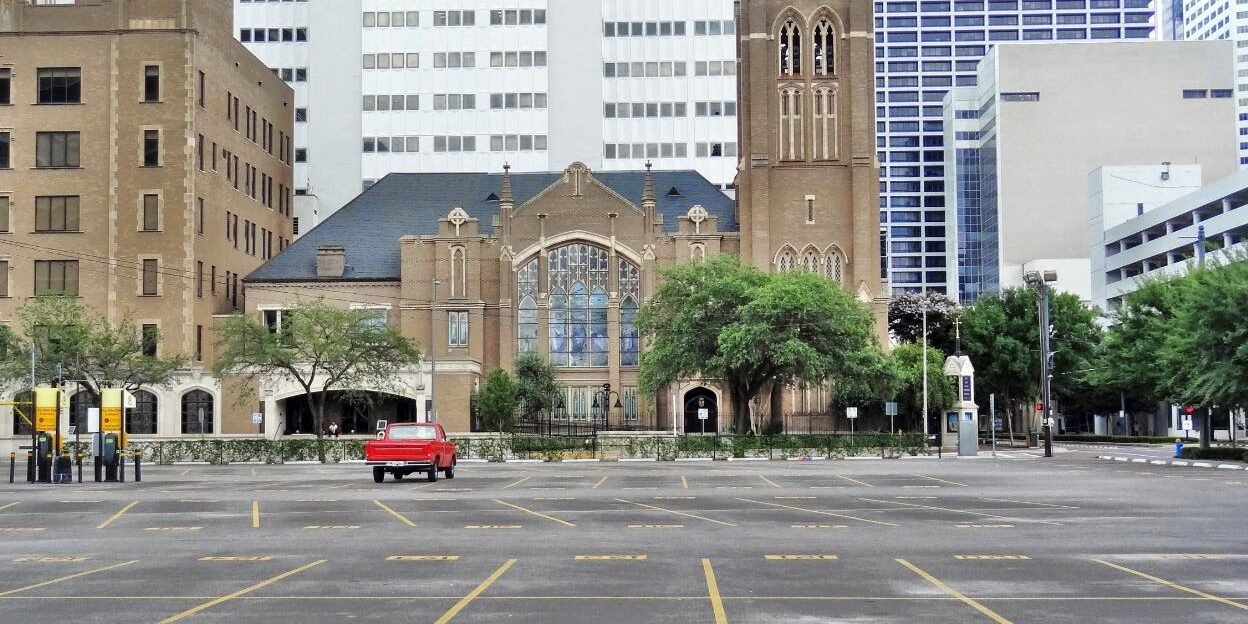|| Written by Paul D. Numrich, Methodist Theological School in Ohio and Trinity Lutheran Seminary ||
What happens when a Catholic church provides overflow parking to a Hindu temple? Is it primarily an exchange of resources? Or is something more going on?
In our book on immigrant congregations, Sacred Assemblies and Civic Engagement, Fred Kniss and I noted with surprise the number of shared parking arrangements we encountered in Chicago.
I am now researching the many variations on space-sharing among religious groups in the US. There are churches that allow other congregations to rent or otherwise use their property, buildings owned jointly by two or more congregations, and congregations that schedule ethnic-specific activities for diverse constituencies.
Shared parking no longer surprises me, but I am learning a lot about the motives and benefits of these arrangements. Often it’s about something other than parking.
People can exchange lots of things—tangible commodities like property, money, or services and less quantifiable matters like status or trust. What besides parking spaces might be involved when religious groups share a lot, especially when no fees are charged?
Take the case of the pseudonymous All Saints Catholic Church described by Brett Hoover in The Shared Parish. Hoover reports that the parish’s Latino priest “on many occasions pleaded that his parishioners obey the parking rules so that they not incur the wrath of the americanos, potentially limiting their ability to conduct ministry.” Here the parking lot symbolizes an exchange of privileges—the dominant Anglo constituency receives reinforcement of its privileged status (by setting the rules) while the larger but subordinate Latino constituency retains parking privileges but only if they follow the Anglo rules.
In the case of the Catholic church and the Hindu temple, what started out as a simple parking agreement helped to integrate the Hindu temple into the local community. As Kniss and I explained, “sharing a parking lot developed into [the temple’s] legitimate place at the neighborhood interfaith table and a voice in neighborhood affairs.” In this exchange, the temple received far more than parking privileges.
When I asked the pastor of a Protestant church to speculate on what the mosque across the street gets out of using the church’s parking lot and other facilities, he replied, “I think they are emboldened to take a bigger part in the culture, realizing that we’ve got their backs. They’re more willing to share their faith and more willing to be a part of what’s going on.” This is borne out by the mosque’s own Website, which draws a direct connection between its relationship with the church and the mosque’s reputation for outreach and interfaith activities.
For many minority religious groups, such arrangements with a majority religious organization can enhance the group’s social status, networking capacities, and/or security. One imam spoke of the “social ground” or “venue” a partnership provides to demonstrate that Muslims are not isolated from the larger society. He sees this as crucial because American Muslims have become “a targeted minority” (his phrase).
In each of these cases, an existing congregation with an established place in the community was keenly aware of its own neighborhood. Tools found on this website can help congregations become more attuned to the social ecology in which they live. The congregations I’ve studied were also aware of the tangible and intangible resources they have. Taking a new look at your own resources might start here.
But sharing is about more than an exchange of resources. Why and how a congregation shares is very much rooted in its identity and tradition – its theology. The Protestant pastor referenced above told me, “What would Jesus have you do? He only gave us two commands, and the second one is about loving your neighbor. These people [members of the mosque across the street] are literally our neighbors.”
I’ve researched another case where a mosque, a synagogue, and a church entered into an agreement that originated in the need for parking but blossomed into an interfaith witness. When I asked the imam about the benefits to his congregation, he emphasized the opportunity to fulfil a divine calling: “God has created us [humanity] different as a challenge for us to show unity and get together and to know each other.”
Guidelines developed by national religious groups echo this theme. ChurchSafety.com, an evangelical website co-sponsored by Christianity Today International, explains that “careful building use can be an excellent form of congregational stewardship, providing hospitality and, in some cases, evangelistic opportunities.” And Sharing Spaces, a manual from the General Board of Global Ministries of The United Methodist Church says, “Mission and ministry are foremost. Sharing a facility as a means of balancing a budget or providing additional income is shortsighted and will lead, ultimately, to dissatisfaction” (emphasis in the original).
Ralph Wilson, director of Joyful Heart Renewal Ministries, agrees: “Financial expediency is not a good enough reason. A host congregation needs to reach Scriptural convictions about sharing its buildings, or the project is likely to falter at the first hint of trouble.”
Thinking about shared space means both a careful assessment of one’s own resources and a thorough immersion in the often-hidden needs and opportunities of one’s neighborhood. Two key questions will remain, however: “Why should we do it?” and “What will we get out of it?” It would be wise to determine early on whether the answers will go beyond the number of parking spaces and potential rental income.
The author wishes to acknowledge grant support from the Louisville Institute.

